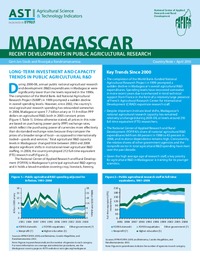Authors:
Stads, Gert-Jan; Randriamanamisa, Rivonjaka
Year:
2010
Publisher
International Food Policy Research Institute (IFPRI); and National Center of Applied Research and Rural Development (FOFIFA)
Back to:
Over the past few decades, agricultural R&D in Madagascar has largely been dependent on donor funding, including consecutive projects financed through World Bank loans and in-kind technical support from France in the form of a relatively large presence of CIRAD expatriate research staff. The completion of NARP and reduced government support led to a sudden decline in the country’s overall agricultural R&D expenditures in the late 1990s, but enhanced technical cooperation from CIRAD in more recent years caused the country’s overall agricultural R&D spending levels to recover somewhat. In 2008, Madagascar spent 7.7 billion ariary or 11.9 million PPP dollars on agricultural R&D (in 2005 constant prices), the equivalent of 0.25 percent of its agricultural GDP. It is however important to note that without the inclusion of salaries of 14 CIRAD research staff from France, these totals would be nearly 25 percent lower.
Although overall agricultural R&D staffing levels have remained relatively stable about 210 FTEs in recent years, the institutional composition of agricultural R&D staff has exhibited important shifts. Between 2000 and 2008, FOFIFA lost close to 20 percent of its local research staff, and despite significant investments in training of human resources under NARP in the 1990s and bilateral grants in the 2000s, the center has lost a large number of PhD- and MSc-qualified researchers in recent years. Many more of the institute’s most senior researchers are due for retirement in the coming years, making hiring and training young scientists one of FOFIFA’s top priorities in the short to medium term.
The launch of various ambitious government-led agricultural and rural policy initiatives stressing the importance of agricultural R&D have not translated into increased in government or donor funding. Without a major increase in funding, many of the agricultural R&D capacity and infrastructure gains achieved over the past 15 years are at risk of being quickly eroded.

